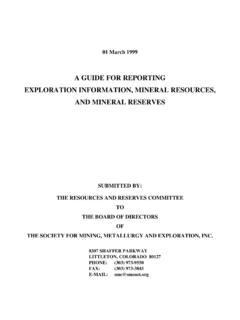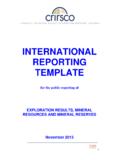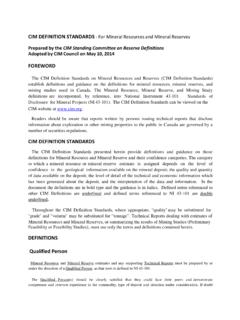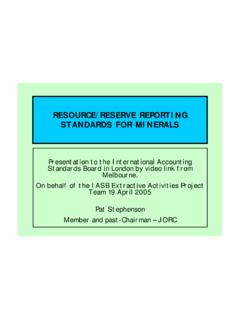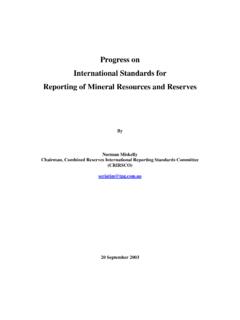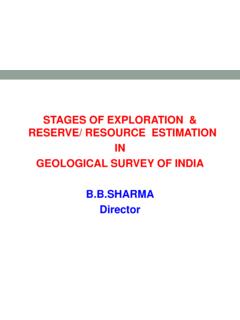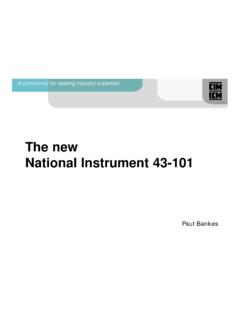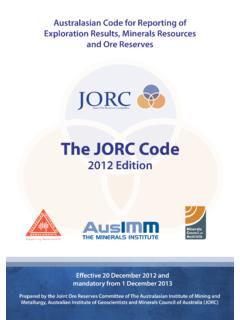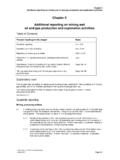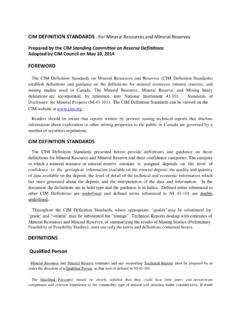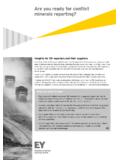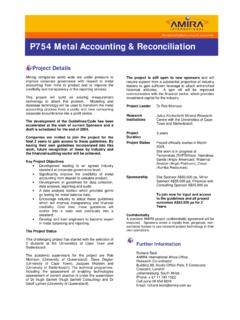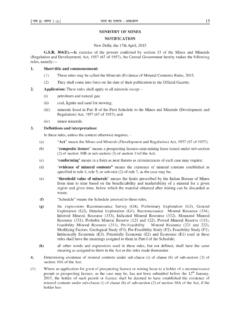Transcription of 080430 International Standards for Reporting of Mineral ...
1 World Mining Congress & Expo 2008. International Standards for Reporting of Mineral Resources and Reserves - Status, Outlook and Important Issues Niall Weatherstone, Chairman, Committee for Mineral Reserves International Reporting Standards (CRIRSCO). Abstract Developing and maintaining International Standards for the Reporting of Mineral Reserves, Mineral Resources and Exploration Results is important. With an increasingly globalised mining industry, the commodity wealth of countries attracting strong political attention and the impact that minerals have on the financial, accounting and investment communities, the need for common terminology and understanding across country boundaries and language barriers has never been higher.
2 Within countries many minerals Reporting systems have been established: some by governments for governments, others by professional and industrial bodies for commercial use. The problem is that these systems don't talk' to each other; just like children of different countries, they come from different backgrounds and speak different languages. This was not so much of a problem in the past as presumably within country borders, there was a general understanding of how the various systems operated and related to each other. Now, however, the globalisation of the mining industry, shown by cross border mergers and acquisitions, corporate listings on multiple International stock exchanges and increasing investment by foreign countries in the developing countries of Asia, Africa and South America, means that an International language is needed to describe the assets of mining companies, and ultimately the Mineral wealth of countries.
3 This paper discusses the current status in the development of International Standards for Reporting Mineral Reserves, Mineral Resources and Exploration Results. It provides a little bit of history, examines current activities and future trends, and identifies some of the issues that need to be addressed to achieve real International understanding of the categories of mineralisation that underpin the mining industry and its ability to supply the increasing demands of its consumers. What is a standard? What do we mean by a standard? A dictionary definition will probably include phrases such as something very widely used and generally regarded as authoritative; implying a level of quality or excellence that is accepted as the norm or by which actual attainments are judged; principles or values that govern behaviour.
4 In the minerals industry many of these words would be familiar to those striving to improve Standards of minerals Reporting . Since the early 20th century when American President Herbert Hoover was a mining engineer, there have been numerous attempts to develop systems', codes' and guidelines' to define the various categories of resources and reserves. Nowadays, systems' tend to be government driven and apply to classifications of mineralisation, whether economic or not, discovered or not, but of use in defining the potential Mineral wealth of a country for the future. Codes are often referred to a must do' documents, and are commonly linked to the regulations of the country involved.
5 Guidelines' are should do' documents; often issued in support of Codes or as standalone documents to direct users towards current best practice in Reporting . In practice the aims of the three types are very similar even if the resulting documents may look quite different from country to country. Collectively, systems, codes and guidelines add up to the Standards that apply in a particular country or jurisdiction. Although mining is historically important in many countries such as Poland and Russia as a supplier of raw materials to industry, until recently the focal point of the mining industry lay in the main mining countries of the West'.
6 Countries such as Australia, South Africa, USA and Canada are major mining Page 1 of 10. World Mining Congress & Expo 2008. centres and, together with Europe and particularly the United Kingdom, are also the main sources of mining capital. It is here that we find the origins of some of the most widely used Reporting Standards today. The development of Reporting Standards a brief history From initial origins in USA, Australia took the lead in providing a Code and Guidelines for defining and classifying Mineral Reserves, Mineral Resources and Exploration Results. The JORC Code was first published in 1989 with further updates in 1992, 1993, 1996, 1999 and 2004 (Reference 1).
7 Figure 1. illustrates how from 1999 onwards, using JORC and its successive updates as a model, there was a rapid increase in the development of new Standards in other countries. So Reporting Standards became an International phenomenon without there being an explicit International standard. JORC (Australia). New Standards PERC (Europe). CIM (Canada). SME (USA). Philippines Chile Peru 1989 1999 2000 2001 2002 2003 2004 2005 2006 2007 2008. JORC (Australia). JORC (Australia). SAMREC (S Africa). SME (USA). SAMREC (S Africa). CIM (Canada). PERC (Europe). in prep. Updated Standards Figure 1 New and updated Reporting Standards 1989-2008.
8 From 1994 on, representatives of all of the major national Reporting organisations (NROs) had met at various times to examine how to converge their national Standards into an internationally recognised form. The key to this was agreement on the definitions of resource and reserve categories so that national Standards would be compatible with each other in this critical way. Under the auspices of the Council of Mining and Metallurgical Institutions (CMMI), the 1997 Denver Accord reached just such a ground-breaking agreement. This was followed in 1999 by an agreement between the CMMI and the United Nations Economic Commission for Europe (UNECE) that the same definitions for minerals would apply in the United Nations Framework Classification for Solid Fuels and Mineral Commodities (UNFC).
9 In July 2006 CRIRSCO1, the successor to the CMMI Working Group, published the first version of its International Reporting Template for Exploration Results, Mineral Resources and Mineral Reserves (Reference 2) modelled on the Standards that existed in all its member countries. CRIRSCO currently represents NROs in Australia, Canada, Chile, South Africa, USA, UK and Western Europe. The Template sets out to provide a model for countries that do not have a national standard or that want to modify their existing systems to make them internationally compatible. The Template is not binding, nor 1. Committee for Mineral Reserves International Reporting Standards Page 2 of 10.
10 World Mining Congress & Expo 2008. does it replace the national Standards that contribute to it. Instead it provides a generic International standard stripped of legal or regulatory components that apply only within individual countries. It is important to note that for a long time the JORC Code was the only Reporting standard commonly in use in the mining industry although it specifically applied only to Australasia. Because of its regional association, including formal links to the Australian Securities Exchange, there was an understandable reluctance to adopt it internationally, particularly amongst companies not listed in Australia or New Zealand.
